
¿Estás listo para duplicar tu tráfico de búsqueda?
Comprender el SEO es esencial para aumentar drásticamente el tráfico y el conocimiento de la marca.
Miles de personas ahora buscan contenido como el suyo. Puede ayudarlos a encontrarlo convirtiéndose en un experto en SEO.
De hecho, el 40% del tráfico del sitio web comienza con una consulta de búsqueda. Por eso la optimización de motores de búsqueda (SEO) es tan importante.
Mantenerse al tanto del SEO requiere mucha investigación y experimentación. Los algoritmos de Google se actualizan constantemente, por lo que es importante estar atento a las últimas noticias. Con un poco de práctica, puede convertirse en su propio experto en SEO.
¡Esto es lo que hice!
Todos los días, las personas utilizan Google para realizar más de 3.500 millones de búsquedas. En los Estados Unidos, el 78% de las personas usa la web para buscar productos y servicios antes de comprar.
Una vez que su sitio web comience a posicionarse en las primeras páginas de los resultados de búsqueda de Google, obtendrá más exposición. Esto significa más tráfico, más conversiones y posiblemente mayores ingresos.
Llegar a la primera página de resultados de búsqueda es vital. ¡El 75% de los usuarios ni siquiera hacen clic en la primera página!

Los tres primeros resultados de búsqueda orgánica obtienen el 60% de todo el tráfico de búsqueda web. Los clientes potenciales de búsqueda tienen una tasa de cierre del 14,6%, en comparación con solo el 1,7% de canales como la publicidad impresa o por correo directo.
¿Ves por qué el SEO es tan importante para tu éxito?
Aquí hay 19 técnicas avanzadas de SEO que puede implementar de inmediato para aumentar su tráfico de búsqueda. Obtener más visitantes también debería ayudarlo a convertir a más personas en clientes.
La optimización de conversiones implica más que solo generar tráfico, como asegurarse de tener un formulario claro de captura de clientes potenciales, una página de ventas y páginas descriptivas de productos.
Pero no se puede vender a personas que no están allí, ¿verdad?
¡Entonces empecemos!
Consejo de SEO avanzado 1. Realice una auditoría de SEO en su sitio web
La auditoría de su sitio web lo ayuda a comprender por qué no obtiene suficiente tráfico de búsqueda y ventas. Muchas empresas de SEO ofrecen este servicio, pero puedes ahorrar mucho dinero haciéndolo tú mismo.
En términos generales, una auditoría es una revisión sistemática de un evento financiero, concepto o libros que se realiza para determinar dónde se encuentra y cómo tomar decisiones más inteligentes en el futuro. .
En el mundo del SEO, la auditoría es una técnica de growth hacking que le ayudará a atraer y retener clientes.
Una auditoría de SEO analiza de cerca el rendimiento general de su sitio, crea objetivos basados en lo que encuentra e implementa tácticas para lograr esos objetivos. Este proceso ayuda a aumentar las ganancias haciendo el mejor uso del contenido que ya posee y resolviendo problemas de SEO.
Puede que no suene como una estrategia avanzada de SEO, pero te sorprendería saber cuántos sitios web carecen de SEO básico en la página, como títulos o descripciones de las páginas. Es fácil de olvidar al crear su sitio web, pero fácil de solucionar con una auditoría.
Esto es lo que debe buscar en una auditoría:
Verificación n ° 1: ¿Todas las páginas de su sitio web tienen metatítulos y descripciones de SEO?
Verificación n ° 2: ¿Todas las páginas de su sitio web están optimizadas para palabras clave de SEO?
¡No olvide optimizar adecuadamente sin el relleno de palabras clave!
Verificación n ° 3: ¿Su estructura de URL está optimizada para motores de búsqueda?
Sus URL deben ser simples, breves y fáciles para que un motor de búsqueda pueda saber de qué trata la página. Aquí un ejemplo:
21 trucos de Bing Ads que aumentarán los clics y reducirán el gasto
¡Apuesto a que puede adivinar que este artículo cubre 21 formas de mejorar sus anuncios de Bing!
Pero, ¿y si la URL tuviera este aspecto?
https://neilpatel.com/blog/archive/2017/05/16/ads/bing/21-hacks/post.html
Suena un poco complicado, ¿verdad? Un motor de búsqueda tendría dificultades para determinar el tema de este artículo porque las palabras clave están desglosadas por carpetas y fechas. No está muy claro.
Cuando se trata de URL, lo simple es mejor.

Marque # 4. ¿Todas las páginas y publicaciones de blog tienen el formato correcto?
Con correctamente me refiero a cada página:
- ¿Romper con títulos y subtítulos (etiquetas h1 y h2)?
- ¿Utiliza de dos a tres oraciones por párrafo?
- ¿Puntos importantes en negrita o cursiva?
- ¿Optimizado con un llamado a la acción?
El 43% de las personas navegan por publicaciones de blogs en lugar de leer todo. ¡Haz que sea más fácil para la gente leer!
Verificación # 5: ¿Todas sus imágenes tienen palabras clave en sus etiquetas ALT?
Verificación n ° 6: ¿Utiliza enlaces en su contenido?
Esto incluye enlaces internos (a su propio contenido) y enlaces externos (a otros sitios web).
Cubriré los enlaces con más detalle más adelante en este artículo, pero esto es muy importante para el SEO como uno de los tres principales factores de clasificación para Google.
Ahora, si desea ahorrar tiempo, existe una forma más sencilla de realizar una auditoría del sitio. A continuación, le mostramos cómo utilizar Ubersuggest para realizar una auditoría del sitio y descubrir oportunidades para mejorar su tráfico de búsqueda:
Etapa 1: Utilice Ubersuggest
Ve a Ubersuggest. Ingrese la URL de su sitio web en el cuadro y presione buscar.

Paso # 2: Ver el analizador de SEO
Serás llevado a una página de resultados. Haga clic en SEO Analyzer. Le llevará unos minutos rastrear su sitio, pero los resultados valdrán la pena, lo prometo.
Paso 3: comprueba tu puntuación de SEO en la página

Este es su puntaje general de SEO en la página para todas las páginas escaneadas durante la auditoría del sitio. 0 es la puntuación más baja posible y 100 es la más alta. Con una puntuación de 84, mi sitio se considera "excelente".
Paso 4: Revise la verificación de estado y los errores

Hay cuatro secciones para revisar:
- Chequeo – Estado general de las páginas de su sitio web
- Errores críticos – Problemas que tienen el mayor impacto en la salud de su SEO
- Advertencias – Problemas menos impactantes que aún merecen su atención
- Recomendaciones – Recomendaciones a considerar, pero que no tienen mucho impacto en la salud de tu SEO
Paso 5: Conozca los principales problemas de SEO

Esta es la última sección de la auditoría del sitio y describe los principales problemas de SEO en la página. Puede hacer clic en cada fila para obtener más información.
Por ejemplo, "21 páginas con meta descripciones duplicadas". Las meta descripciones únicas y atractivas son esenciales para aumentar la tasa de clics desde los resultados de búsqueda hasta su sitio web.
Cuando realiza una auditoría completa de SEO de un sitio web, es probable que encuentre al menos algunos errores o sugerencias de mejora. ¡Nadie es perfecto!
Ubersuggest es una excelente herramienta de SEO para monitorear el rendimiento de su sitio web y publicación de blog.
Consejo de SEO avanzado 2. Descubra lo que quieren sus usuarios
Google no es una agencia de publicidad. Esta es una empresa de big data.
Cada herramienta, plataforma y dispositivo que crean tiene un objetivo: obtener datos de los usuarios y utilizarlos para crear un motor de búsqueda más potente.
Piense en usted mismo como una empresa de big data.
Debe concentrarse en lo que quieren sus clientes objetivo. Cuando comprenda lo que quieren, puede desarrollar contenido que les atraiga.
Cuando escucha los comentarios de su cliente objetivo, guía el contenido que crea para atraer más.
Las opiniones de sus usuarios son importantes. La audiencia determina qué idea, artículo, producto o concepto se compartirá o financiará.
Piense en Kickstarter. La mayoría de las campañas pasan desapercibidas durante días hasta que algunas personas donan el dinero. Luego le siguen otras personas.

Entonces, ¿Cómo obtener datos relevantes sobre los intereses de sus usuarios?
¿Y cómo obtiene comentarios de su cliente ideal si recién está comenzando y no tiene ningún cliente real para preguntar?
Hay varias formas de averiguarlo:
- Usa plataformas de redes sociales como Quora
- Vea sus páginas más populares en Google Analytics
- Ver qué publicaciones se comparten más
- Escuche los comentarios de los visitantes en las publicaciones de su blog
Cubramos el primero: las plataformas de redes sociales.
Pregúntese: "¿Dónde pasan el rato en línea las personas que quiero atraer y de qué temas están hablando?"
Personalmente, me encanta usar Quora.
Me da una idea de lo que está hablando mi público objetivo y puedo aprender de los expertos en el proceso. Si quisiera escribir un libro o un curso, las cosas que la gente pregunte en Quora serían fuentes útiles de ideas de contenido.
A continuación, le mostramos cómo averiguar qué quieren usar las personas con Quora:
Paso # 1: Ve a Quora
Deberá crear una cuenta o iniciar sesión con Google o Facebook para acceder a ella.

Una vez que haya iniciado sesión, ingrese su palabra clave principal (por ejemplo tráfico del blog) y presione Entrar.

Paso 2: vea las preguntas que hacen las personas
Si sabe cómo responder a cualquiera de estas preguntas, escriba una publicación de blog al respecto.
Ya sabes que la gente quiere saber más sobre este tema. Si una persona lo ha preguntado en Quora, es probable que cientos de personas se pregunten exactamente lo mismo.

Paso 3: obtenga información de los expertos
Quora es un gran lugar para aprender cosas nuevas. Cuando se trata de SEO avanzado, nunca se puede saber todo, así que lo visito con frecuencia para aprender de los demás.

Actualmente hay 16 respuestas diferentes a esta pregunta. La captura de pantalla anterior es solo una de ellas, pero puede imaginar la cantidad de contenido de alta calidad que podría crear solo con esa respuesta.
Utilice estas respuestas para formar el plan para su próxima publicación de blog.
Cómo utilizar Google Analytics para averiguar qué quieren los lectores
También puede utilizar Google Analytics para averiguar qué quieren sus lectores.
Etapa 1: Inicie sesión en Google Analytics. En el menú de la izquierda, haga clic en Comportamiento -> Contenido del sitio -> Todas las páginas.
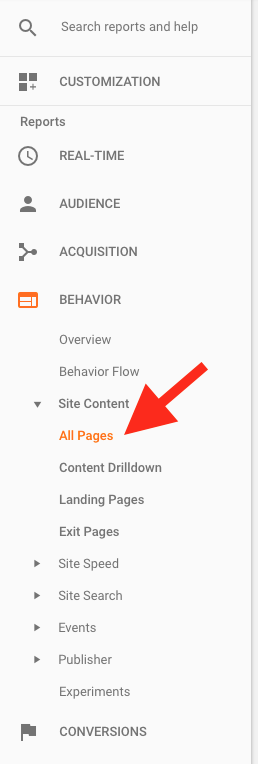
2do paso: Vea cuáles son sus páginas y publicaciones más populares.
El número total de páginas vistas es importante, pero también observe el tiempo promedio que pasa en la página (¡cuanto más alto, mejor!), La tasa de rebote y el porcentaje de salida.
Aquí están mis mejores páginas del 14 de mayo al 14 de junio de 2017:

El tiempo promedio que se pasa en la página le dice si las personas realmente se tomaron el tiempo para leer su publicación completa o simplemente pasaron el mouse sobre ella.
¿Menos de un minuto debería ser una señal de que las personas están navegando rápido y no están leyendo su artículo?
Entonces, si veo un promedio de treinta segundos, sabré que la gente no encontró mi publicación tan interesante para quedarse por mucho tiempo.
El porcentaje de rebote le indica el porcentaje de personas que llegaron a esa página, pero luego se fueron sin visitar otras páginas. Esto no es un indicador de éxito o fracaso per se, pero lo ideal es que la gente se quede y vea al menos 2-3 páginas.
El porcentaje de salida le indica que para esa página en particular, el x% de los usuarios abandonaron su sitio después de visitar esa página. Al igual que la tasa de rebote, no es un indicador de un problema en sí, pero si su tasa de salida es del 99%, eso probablemente significa que los usuarios no están encontrando lo que es. 39; quieren saber sobre esta página y no quieren explorarla más.
Otra excelente manera de averiguar lo que quieren las personas es ver con qué frecuencia se comparte su contenido en las redes sociales.
BuzzSumo es una gran herramienta para esto. Simplemente ingrese la URL de su sitio web y presione Aceptar.

Le dará una lista de su contenido más popular, ordenado por el mayor número de compartidos.
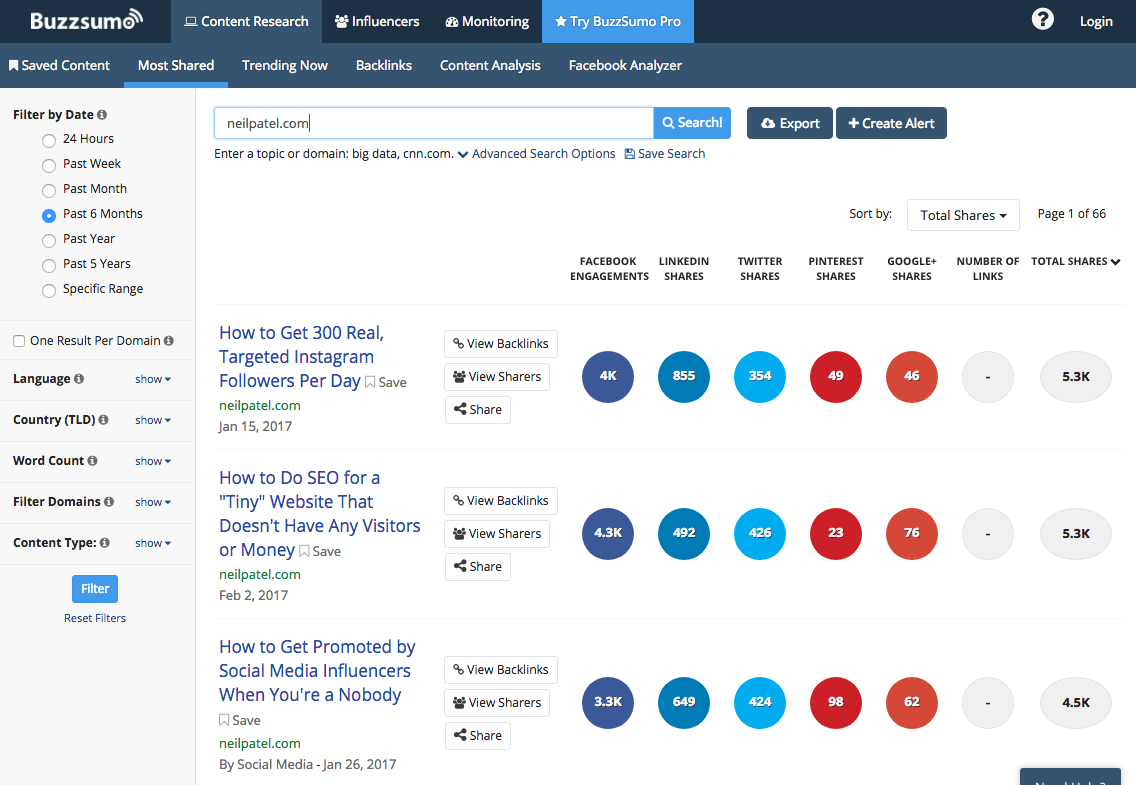
Esto le permite saber qué publicaciones le gustan lo suficiente a la gente para compartir. La razón más común por la que las personas comparten contenido es cuando creen que será útil para los demás.
Dicho esto, el número total de veces que se comparte tu publicación es una buena manera de saber si las personas encuentran útil tu contenido.
¿Quiere conocer la forma más sencilla de averiguar qué piensan sus usuarios? Simplemente lea sus comentarios en sus publicaciones.
Cuando responda a las preguntas de usuarios reales con su contenido, su tráfico de búsqueda mejorará drásticamente.
Consejo avanzado de SEO 3. Cree páginas de destino optimizadas para SEO
Una página de destino bien diseñada puede mejorar la generación de clientes potenciales y las ventas. Cuantas más páginas de destino cree, más puertas de enlace abrirá para el tráfico de búsqueda entrante.
Desafortunadamente, pocas empresas B2B comprenden completamente la importancia de utilizar páginas de destino específicas para atraer nuevos usuarios.
Según la firma de investigación de SEO MarketingSherpa, el 44% de los clics de negocios B2B van a una página de destino, no a una página de destino. Por supuesto, la página de inicio es importante, pero una página de destino es donde puede comenzar una relación sólida.
Aquí un ejemplo.
Copyblogger crea páginas de destino de alta calidad sobre temas populares. Van un paso más allá con gráficos profesionales y un diseño moderno y limpio.
Luego, dirigen tráfico a la página de destino a través de comunicados de prensa, marketing por correo electrónico y optimización SEO.
Esta es una de sus páginas de destino en las páginas de destino.

A medida que se desplaza hacia abajo, obtendrá más información sobre las páginas de destino:

Los elementos clave de una buena página de destino son:
- Sin navegación (¡desea que los usuarios permanezcan en la página!)
- Contenido útil e informativo
- Una llamada a la acción (para registrarse en su producto, servicio, descargar un lead magnet o algún otro tipo de acción)
En la página Copyblogger, tienen contenido útil con enlaces a artículos relevantes:
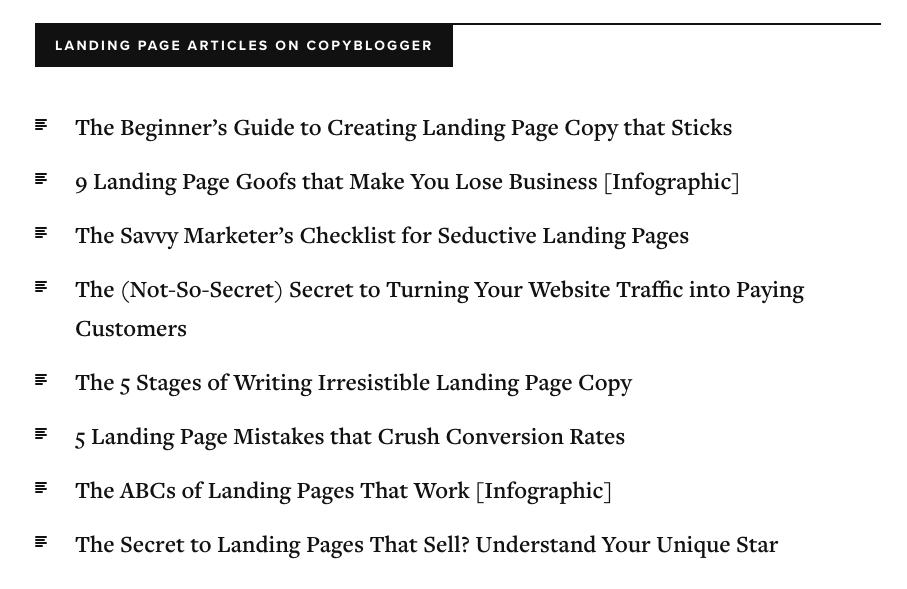
Y una llamada a la acción clara y notable:

¿Crees que estas páginas de destino tienen un buen valor SEO?
¿Las personas se conectan con ellos y los comparten en las redes sociales?
Vamos a averiguar.
Vaya a Ahrefs.com. Ingrese la URL de una página de destino (usemos http://www.copyblogger.com/copywriting-101/) y haga clic en Buscar enlaces.

Como puede ver en la captura de pantalla anterior, esta página de destino tiene 799 enlaces entrantes confiables, más de 1000 tweets y 446 me gusta en Facebook. Esta página de destino claramente está haciendo su trabajo de convertir visitantes en clientes potenciales.
Las páginas de destino pueden generar muchos ingresos.
Los expertos en tasa de conversión ganaron $ 1 millón para Moz, utilizando una única página de destino optimizada y algunos correos electrónicos.

Las empresas con 10-15 páginas de destino obtienen un 55% más de conversiones que aquellas con menos de 10 páginas de destino.
¡Las empresas con más de 40 páginas de destino obtienen un 500% más de conversiones!
Basecamp tiene una gran página de inicio para registrarse y obtener una prueba gratuita de su producto.

Te atrae con un titular en negrita. Destaca los puntos clave en una lista para una descripción general sencilla. También cuenta con un formulario de registro visible.
Pero las buenas páginas de destino no siempre tienen que ser una sola página. Vea este ejemplo de Bills.com:

Ofrece una forma interactiva de atraer visitantes. Primero, selecciona el monto de su deuda.
Elegiré $ 50,000.
Luego, la página de destino me hace una serie de preguntas, que son las preguntas de precalificación empresarial para nuevos clientes potenciales.
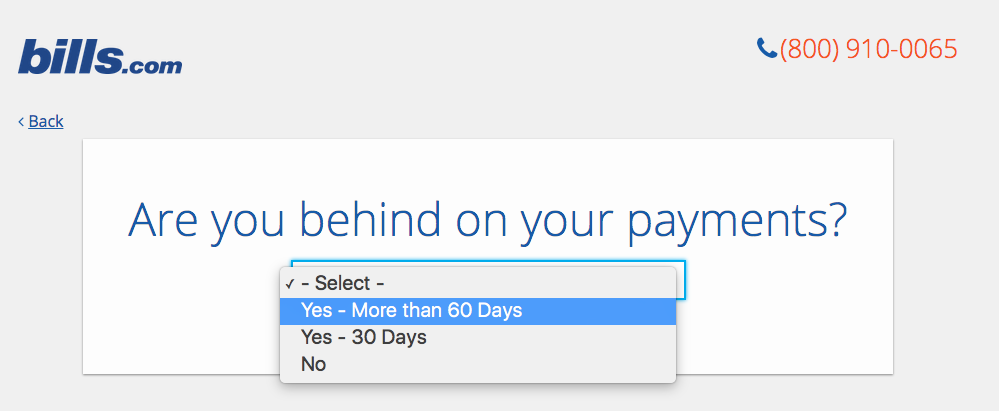
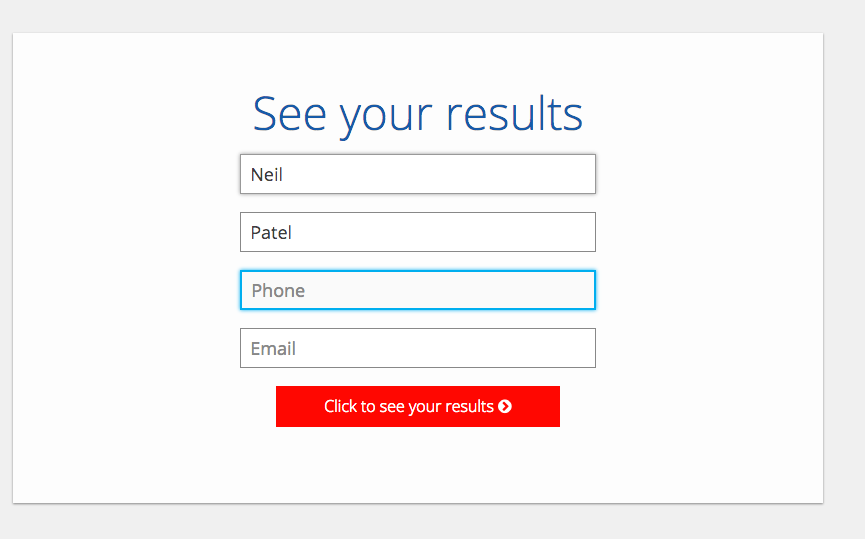
Para ver mis resultados, debo ingresar mis datos. Es posible que algunos visitantes no quieran y abandonen la página de destino en este momento, pero aquellos que realmente quieran saber si su programa de alivio de la deuda les ayudará a completarla.
Esta es una página de destino muy simple que genera miles de clientes potenciales por mes para Bills.com.
Este es un gran ejemplo de cómo el diseño simple y los elementos interactivos pueden unirse fácilmente para generar grandes resultados.
A continuación, le indicamos cómo asegurarse de que su página de destino esté optimizada para SEO.
Paso 1: use palabras clave de cola larga
Encuentre una palabra clave de cola larga y úsela en toda su página de destino. Por ejemplo, Copyblogger apunta a la palabra clave "Redacción SEO" en una de sus páginas de destino.

Si está utilizando Optimizepress u otro creador de páginas de destino para WordPress, asegúrese de agregar etiquetas de título, descripción de metaetiquetas y palabras clave.
Use palabras clave de forma natural en todo su contenido para evitar ser penalizado por el exceso de palabras clave. Incluya su palabra clave de cola larga en el título, al menos un subtítulo en la página y algunas veces en el contenido de su cuerpo.
Paso 2: use una copia convincente para compartir información útil
El contenido de su página de destino debería ser útil.
Escriba para persuadir a la gente de que dé el siguiente paso. Cada experto en SEO le dirá que el objetivo número uno de cualquier texto atractivo es lograr que lea la siguiente oración.
Recuerde, la anatomía de una página de destino exitosa comienza con el título. El contenido de su cuerpo también es importante y debe incluir un testimonio o revisión de un cliente para agregar confianza y credibilidad.
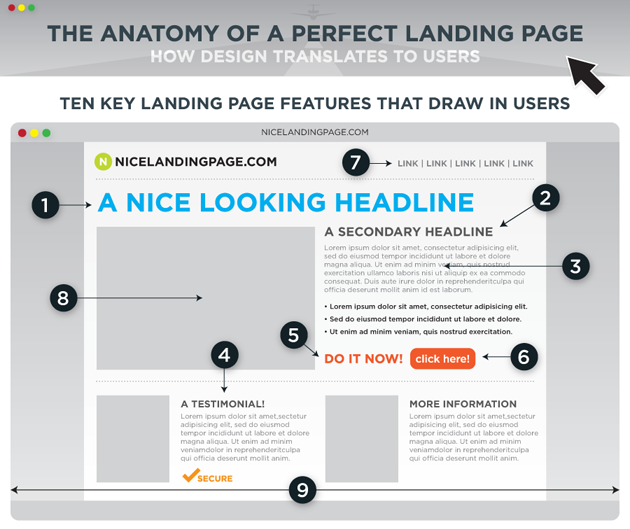
Paso 3: usa un diseño profesional
También querrás asegurarte de que tu página de destino sea moderna con un diseño profesional.
"El diseño es el rey", dice Derek Halpern. Si su contenido es útil, pero su diseño apesta, es probable que falle.
Las páginas de destino necesitan un texto sólido, un video atractivo que sea emocionalmente atractivo y testimonios de clientes satisfechos, que contribuyen en gran medida a ganar nuevos clientes.
Paso 4: crea enlaces
Finalmente, cree enlaces desde su contenido existente a su nueva página de destino.
No hay alternativa a la construcción de enlaces. Los enlaces son un factor de clasificación enorme para Google y probablemente siempre lo serán.
Sin enlaces de calidad, es poco probable que su página tenga una clasificación muy alta en la búsqueda, incluso si tiene una excelente copia o usa todos los demás factores de clasificación de SEO. Dado que la mayoría de los usuarios nunca miran más allá de la primera página de resultados de búsqueda, es importante clasificar lo más alto posible.
Consejo avanzado de SEO 4. Haga que su sitio web sea compatible con dispositivos móviles
Es más importante que nunca asegurarse de que su sitio web se vea bien y funcione bien en dispositivos móviles. De hecho, diría que tiene que ser más que compatible con dispositivos móviles: tiene que funcionar realmente bien en dispositivos móviles.
Desde que Google cambió primero a los dispositivos móviles, ha mejorado drásticamente el ranking de búsqueda orgánica para sitios web que funcionan bien en dispositivos móviles.
Más del 60% de las búsquedas diarias se realizan ahora en un dispositivo móvil.
Cuando se trata de comercio electrónico, las cifras son aún más sorprendentes. Business Insider predice que para 2020, el 45% de todas las ventas de comercio electrónico (también conocido como comercio móvil) en los Estados Unidos se realizarán en un dispositivo móvil. ¡Eso es $ 284 mil millones solo en los Estados Unidos!

Todas estas estadísticas apuntan a una cosa: simplemente no puede permitirse dejar de tener un sitio web compatible con dispositivos móviles.
Hacer que su sitio sea atractivo en dispositivos móviles ya no es un lujo, es un estándar.
¿Cómo saber si su sitio web es compatible con dispositivos móviles o no? Consulte el siguiente ejemplo de Google.

En el Ejemplo X, el sitio web se ve exactamente como el de su computadora de escritorio. El contenido no cambia de tamaño para adaptarse mejor a una pantalla más pequeña.
En el ejemplo de la marca de verificación verde, ¿ves cómo el mismo contenido se vuelve a alinear para usar mejor la pantalla pequeña? Es más fácil de leer y desplazarse. Esto es lo que significa ser compatible con dispositivos móviles.
Si está utilizando WordPress como CMS para su sitio web, probablemente ya tenga un sitio optimizado para dispositivos móviles. Casi todos los temas de WordPress de los últimos años están diseñados para responder, que es el término de diseño móvil.
Según Wikipedia, el diseño receptivo significa:
Sitio web adaptable (RWD) es un enfoque del diseño web destinado a hacer posible la visualización de páginas web de escritorio en función del tamaño de la pantalla o del navegador web que se está viendo actualmente. Además, es importante comprender que las tareas de Responsive Web Design incluyen brindar el mismo soporte a una variedad de dispositivos para un solo sitio web.
¿Aún no estás seguro de que tu sitio web sea compatible con dispositivos móviles? Solo compruébalo en tu teléfono.
Así es como se ve mi sitio en una computadora:

Y cómo se ve en el móvil:

¿Ver la diferencia? El sitio móvil está optimizado para el ancho de mi pantalla y es fácil de leer.
Si desea asegurarse de que su sitio web cumple todos los requisitos para ser compatible con dispositivos móviles, utilice la herramienta gratuita de prueba para dispositivos móviles de Google.
Ingrese la URL de su sitio web y haga clic en Ejecutar prueba.

Obtendrá una página de resultados que le dirá si su sitio es compatible con dispositivos móviles o no.

Si su sitio no es compatible con dispositivos móviles, es hora de reconsiderarlo.
Probablemente pueda realizar algunos cambios en el diseño de su sitio web existente para mejorar su usabilidad móvil. Pero puede ser más rápido y económico a largo plazo conseguir un sitio web totalmente nuevo. Considérelo como una buena oportunidad para actualizar su marca al mismo tiempo.
Consejo avanzado de SEO 5. Aumente su tráfico con infografías
Las infografías son populares porque le permiten mostrar información compleja de una manera fácil de entender. Dado que el 65% de las personas aprenden visualmente, un gráfico va mucho más allá que un simple artículo textual.
Aquí hay una buena infografía sobre las infografías de NeoMam Studios:

He estado creando infografías durante un tiempo y los resultados son impresionantes. En KISSmetrics hemos generado 2.512.596 visitantes y 41.000 backlinks en 2 años, utilizando infografías.
Las infografías de calidad pueden aumentar el tráfico de su sitio web en un 193%. Lo hice en solo un año.
Desafortunadamente, la mayoría de la gente no presta atención a la parte de "información". En cambio, se centran en los gráficos. Un buen diseño es importante, pero es necesario contar con datos de calidad que lo respalden.
Los estudios demuestran que una infografía tiene 30 veces más probabilidades de ser leída que un artículo de texto normal. En moyenne, les sites Web qui publient des infographies génèrent un trafic 12% plus rapide que ceux qui ne le font pas.
Pourquoi les utilisateurs de recherche et les consommateurs préfèrent-ils les infographies?
C'est parce que le cerveau humain traite les données visuelles 60 000 fois plus rapidement que le texte brut. De plus, 90% des informations transmises au cerveau humain sont visuelles.

Vous pouvez générer jusqu'à 60000 visiteurs de recherche sur votre site Web avec des infographies!
Voici comment:
Étape n ° 1: Obtenez vos statistiques
Trouvez un sujet ou une idée tendance que les gens recherchent et compilez des statistiques à ce sujet.
Par exemple, si vous souhaitez créer une infographie sur des infographies, vous pouvez prendre les quelques statistiques que nous avons répertoriées ci-dessus:
- Vous pourriez générer jusqu'à 60 000 visiteurs
- Votre trafic pourrait croître 12% plus vite
- Une infographie a 30 fois plus de chances d'être lue
Étape n ° 2: créer l'infographie
Il existe de nombreux sites Web gratuits avec lesquels vous pouvez créer des infographies, comme visual.ly, Canva et Venngage.
Vous ne voulez pas le créer vous-même? Vous pouvez engager un graphiste professionnel sur Dribbble. Recherchez simplement des infographies en haut.

À partir de là, choisissez un designer et lisez son profil.
Si vous souhaitez le créer vous-même, voici comment le faire avec Canva.
Connectez-vous à Canva et cliquez sur Créer un design, puis choisissez infographie.
Canva vous propose de superbes mises en page pour commencer. Choisissez-en un sur le côté gauche. Cliquez n'importe où sur l'infographie pour commencer à la modifier.

Vous pouvez modifier le texte et les images jusqu'à ce que vous soyez satisfait du résultat. Canva propose également une bibliothèque d'icônes, de photos, de formes et de graphiques gratuits que vous pouvez trouver sous l'onglet Éléments.
Une fois votre infographie prête, cliquez sur Télécharger en haut et enregistrez-la en tant que fichier PNG. Cela le téléchargera automatiquement sur votre ordinateur.

Étape n ° 3: rédigez un article de blog basé sur votre infographie
Prenez les données de votre infographie et transformez-les en un article détaillé pour accompagner le graphique.
Les gens sont plus susceptibles de partager votre infographie si elle est accompagnée d'un article qui l'explique.
Par exemple, si votre infographie s'intitule «10 façons d'accélérer le chargement de votre site», vous pouvez développer chacun des conseils de votre article de blog.
Si vous pouvez publier un contenu unique d'au moins 2000 mots et le coupler à votre infographie, votre trafic de recherche doublera au fil du temps.
N'oubliez pas que Google n'indexe pas le texte de l'infographie, qui fait partie du fichier image. La seule chose que Google indexe est l'image elle-même.
Lorsque vous créez un article de blog pour l'accompagner, Google indexera ce contenu et augmentera la probabilité que votre infographie apparaisse dans les résultats de recherche d'images pour ce mot-clé.
Étape 4: Soumettez votre infographie aux répertoires
Une fois que vous avez votre infographie, soumettez-la à ces 20 principaux répertoires infographiques.
Si vous ne voulez pas prendre le temps de le faire vous-même, vous pouvez trouver quelqu'un sur un site comme Fiverr pour le faire à votre place. Recherchez simplement "soumettre des infographies".

Cliquez sur les services de soumission et étudiez-les attentivement. Vous devriez demander aux fournisseurs de vous montrer les sites auxquels ils ont l'intention de se soumettre. Si vous n'êtes pas à l'aise avec les sites qu'ils nomment, faites-leur savoir. Vous les embauchez, ce qui signifie que vous avez le contrôle!
Remarque: Concentrez-vous sur les liens de qualité plutôt que sur la quantité pour éviter une pénalité de Google. De cette façon, vous améliorerez votre trafic de recherche et maintiendrez votre classement.
Astuce SEO avancée 6. Optimiser le contenu pour RankBrain
Les moteurs de recherche ont beaucoup évolué depuis le lancement de Google en 1998.
Si vous souhaitez continuer à prospérer dans les classements de recherche, vous devez être au courant de toutes les dernières mises à jour des algorithmes de Google et des meilleures pratiques en matière de référencement.
RankBrain est un système d'intelligence artificielle qui permet d'analyser les résultats de recherche. Il apprend ce qu'est une page de contenu et comment cela se rapporte aux mots-clés que les internautes recherchent. Essentiellement, cela permet de connecter une recherche avec des résultats pertinents.
Supposons que vous recherchiez "travail à distance".
Cela pourrait signifier plusieurs choses différentes:
- Vous recherchez des emplois à distance ou à distance / télétravail
- Votre télécommande du téléviseur est cassée et vous souhaitez la faire fonctionner à nouveau
Comment Google sait-il lequel vous voulez?

RankBrain se met au travail et détermine que vous voulez la première option basée sur des milliers d'autres recherches sur le Web effectuées par des personnes recherchant le même terme.
Un exemple plus populaire serait la différence entre la recherche d'Apple et d'Apple:
- Un fruit
- Une grande entreprise informatique fondée par Steve Jobs
Alors, comment pouvez-vous dire à Google la «pomme» exacte à laquelle vous faites référence? Est-ce la société Apple ou la pomme? Ou est-ce quelque chose de différent mais lié?

RankBrain indique aux araignées de Google comment indexer votre contenu en fonction de votre intention.
Étant donné que Google est beaucoup plus sophistiqué ces jours-ci, nous n'avons plus besoin de remplir notre contenu de mots-clés pour lui faire comprendre notre intention.
Quoi que vous fassiez, n'insérez pas de mots clés dans votre contenu!
Le bourrage de mots-clés consiste à abuser des mots-clés et des expressions qui se rapportent au mot-clé principal pour tenter de se classer plus haut dans la recherche. C'est une mauvaise pratique SEO que vous devriez éviter à tout prix.
Par exemple, considérez ces mots clés associés: Avis iPhone, meilleurs avis iPhone, nouveaux avis iPhone. Lorsque vous utilisez tous ces mots clés dans votre contenu, il est probable que Google ne classera pas bien cette page, surtout si le contenu ne fait que quelques centaines de mots.
Voici un exemple de paragraphe bourré de mots clés:
Voulez-vous apprendre Java en ligne? La plupart des didacticiels java ne sont pas créés pour aider les débutants à apprendre java en ligne, car les plates-formes d'apprentissage java en ligne ne sont pas conviviales. Mais aujourd'hui, dans la région de Los Angeles, vous pouvez facilement apprendre java en ligne dans le confort de votre maison et devenir un expert en ligne java.
Pas génial, non?
Le mot-clé principal «java online» a été mentionné quatre fois, ce qui est trop souvent pour un paragraphe aussi court.
Il existe un meilleur moyen de modifier ce paragraphe et de le rendre plus centré sur l'utilisateur, sans négliger le mot clé principal – «java en ligne». Tout ce que vous avez à faire est de trouver des synonymes pour le mot-clé. Par exemple:
Êtes-vous prêt à apprendre Java en ligne? C’est une bonne étape pour améliorer vos compétences et vous donner de meilleures chances d’obtenir ce poste. Il existe plusieurs endroits pour apprendre Java sur le Web, et d'ici 2 à 3 mois, vous programmerez en Java. La plupart des gens n’apprécient pas l’idée de suivre des cours Java en ligne, mais je pense que c’est l’un des moyens les plus flexibles d’accéder à une mine de connaissances et de devenir compétent dans la poursuite de votre vie.
La différence est claire, non?
Le deuxième paragraphe sonne mieux aux utilisateurs et utilise toujours votre mot-clé sans en faire trop.
C’est la puissance de RankBrain.
Quelques conseils pour trouver des synonymes pour votre mot-clé principal:
- Trouvez des mots-clés ayant la même signification que le mot-clé principal, mais avec une orthographe et une structure différentes. Exemple: image, image, photo.

- Ne suroptimisez pas les autres mots clés ou vous pourriez être pénalisé. Utilisez-les uniquement lorsque cela est nécessaire et assurez-vous que votre copie s'écoule naturellement lorsqu'un humain la lit!
- Écrivez sur un ton naturel. Assurez-vous que les nouveaux mots clés ne remplacent pas le mot clé principal pour lequel vous souhaitez classer. The new key phrases are only there to give additional meaning to your content and to help Google understand the context of what you’re talking about.
A good example of these practices is Marketing Land.
Marketing Land optimizes content for a main keyword and several synonyms. They know that once YouTube is mentioned, terms like videos, channels, y video source need to be mentioned, too.
Where Facebook is mentioned sharing, liking, y commenting are also included as they’re all common activities that take place on the platform.

Google looks out for these key terms in your content. As long as you’re including them in a natural-sounding way, your search rankings will continue to improve.
Advanced SEO Tip 7. Write at Least 1,447 Words
Backlinko analyzed 11.8 million searches and found the mean first-page search result had 1,447 words.
There have been numerous studies and experiments on the correlation between content length and search engine ranking.
This graph from Backlinko pages with a higher word count tend to help you crack the first page of Google. It won’t necessarily help you hit number one, but it can help you get close.
I did an experiment for QuickSprout. The results showed that my posts over 1,500 words received almost double the amount of social shares than the ones under 1,500 words.

Content length isn’t everything. A shorter blog post that’s higher quality will still outperform a longer, low-quality post.
The trick is to cover one topic in so much detail that every part of the post is valuable to the reader. Making it more valuable to humans makes it more valuable to Google as a page to display in search results.
A key benefit of longer content is that it will naturally contain more relevant keywords and rank for them.
Consistently publishing informative content over 1,447 words will yield big returns in organic search traffic.
Advanced SEO Tip 8. Write a Roundup Post
A roundup post is when you interview a few people about the same topic or make a list of the “best” of something.
Not only is it a great way to get different viewpoints and learn new things, it also helps grow your SEO rankings and traffic.
Here’s an example: 53 Best SEO Experts of 2020: A More Diverse Roundup
The author of this post collected the names and profiles of experts in their field, including where they work, what type of information they share, and where to follow them.
It seems simple because it is, and it works!
The key benefit of these posts is that it allows you to get your website in front of lots of new audiences, thanks to the experts you’re interviewing.
If you were featured in a roundup, you’d share that with your audience, right?
Deirdre Breakenridge is one of the experts featured in the post above about PR. She has over 30,000 Twitter followers.

If she tweeted out your roundup post even once, there’s a good chance some of her audience would click to read it.
Those are people you wouldn’t have been able to reach otherwise.
Creating a roundup post that grows your traffic is easy:
Step #1: Pick a Topic and a Good Question
For example, if I wanted to write a post about tips to grow your traffic, I could ask, “What one strategy has grown your website traffic the most?”
Step #2: Make a List of Experts and Reach Out
Make a list of as many experts in the topic you want to write about as you can. If you want to feature 10 expert opinions, make a list of 20 experts at least.
It may not be easy to find their email addresses, so write down their social media profiles instead.
Then, reach out with a nice email/social media message and ask them for their opinion!
Remember to include that you’ll be linking back to their website as a thank you for contributing.
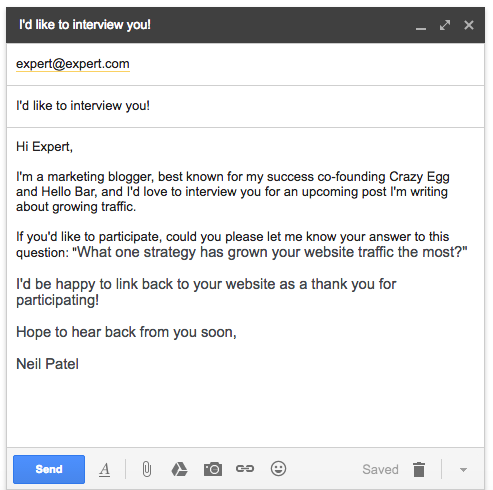
Step #3: Write and Publish the Post
Collect all the answers, then write and intro and conclusion. Make sure to link back to everyone featured.
After you’ve published it, be sure to send a follow up email, or social media message, to let them know the post went live.
Ask them to share it with their audience.
Even if only half of your 10 experts share it, that’s still five more audiences than you would have reached by yourself. And depending on the size of your expert’s audience, that could be thousands or tens of thousands of new people visiting your website.
Brian Liang wrote a roundup post about how to promote your blog.
He got over 40 experts to contribute to it, resulting in a comprehensive and informative piece that got over 5,000 shares on social media. It was also Buzzsumo’s most shared post of that week for the term “blog promotion.”
The biggest wow factor? His blog wasn’t even well-known at the time!
What would 5,000 shares do for your brand?

Advanced SEO Tip 9. Post Valuable Content on Social
If your blog is new, it can be difficult to rank well in Google search results for high volume keywords because your Domain Authority and Page Authority are still very low.
However, you can use social media platforms to gain credibility and traffic.
In the screenshot below, you can see the Page Authority (PA) and Domain Authority (DA) for each search result. I’m using the free MozBar to see this information.
Page Authority was developed by Moz, and it means the likelihood that your page will rank highly in search. A higher number means it’s more likely to rank well.
This is based on several factors: content length, links, keywords, readability and more.
Domain Authority is the overall likelihood that your whole website, or domain, will rank highly in search.

But not all social media platforms are created equal when it comes to building authority and traffic.
I’m not talking about Facebook, Twitter, or Pinterest where anyone can post whatever they want. I’m talking about authoritative platforms where quality content is expected.
A few examples are Slideshare, Blogger, and Quora. These sites give you the opportunity to improve your search rankings, as well as build a following, within a short period of time.

Does leveraging authority social platforms increase your search traffic and rankings?
Oui!
For example, Ana Hoffman got 243,000 views in 30 days, in addition to other benefits, using Slideshare content. Her presentations were among the top most-viewed slide decks.

If you’d like to leverage Slideshare as a search traffic booster, here are the basic steps that you should take:
Step #1: Find a Trending Topic
In my experience, simply selecting a keyword and creating a top-notch slideshow presentation doesn’t always generate buzz on social media.
Instead, look for topics that are already trending on blogs. Just as you do when looking for blog post ideas, you should identify what people are talking about right now.
Another great place is GrowthHackers, an online community of marketers. You’ll find lots of trending topics. Pick one that interests you and is related to your business or industry.
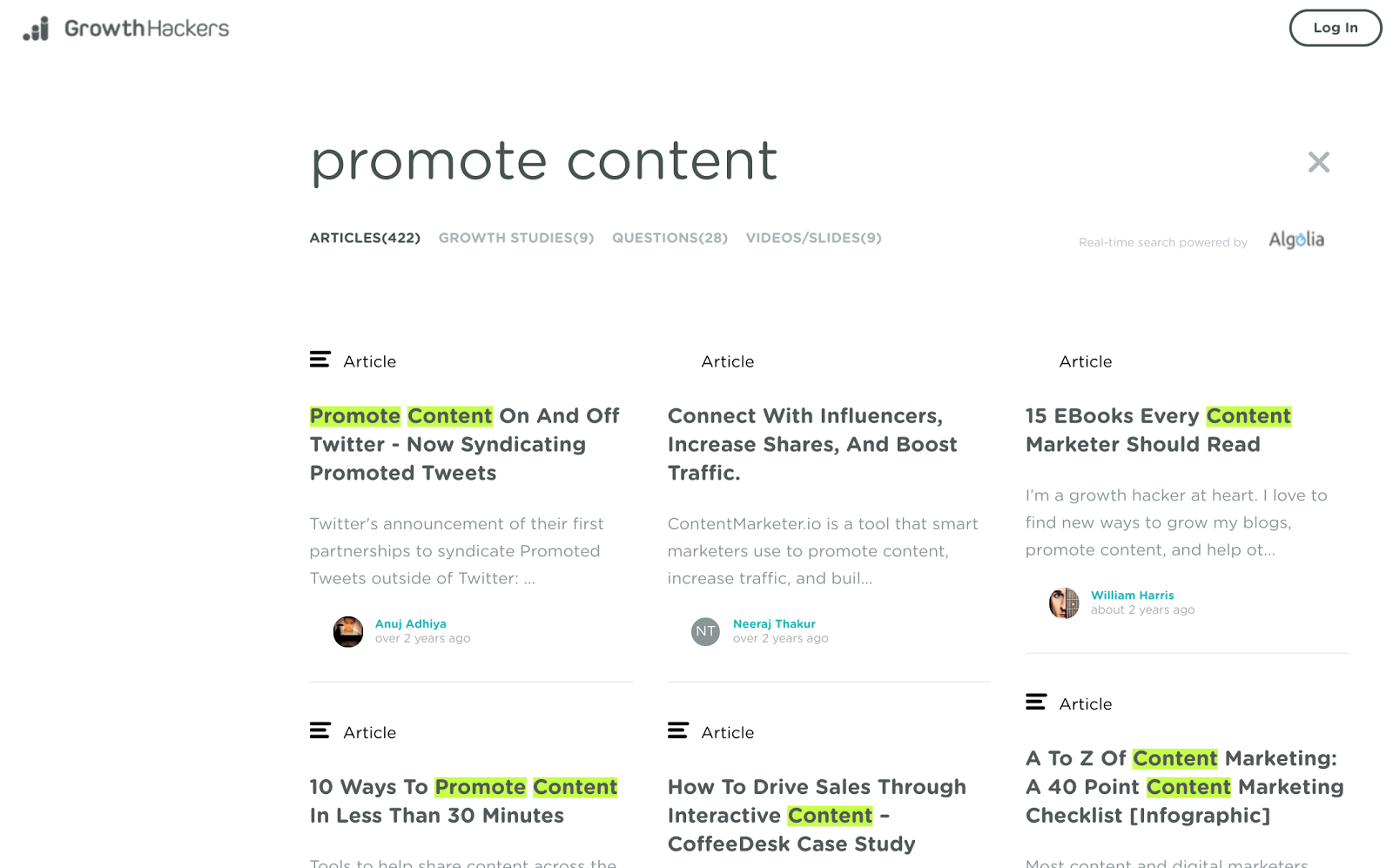
The article titled “10 Ways to Promote Content in Less Than 30 Minutes” would make a good Slideshare presentation.
Don’t feel pressured to crank out 50 or 100 slides.
Aim for about 35 slides. This gives a user a good amount of information without being too long to keep their attention.
Step #2: Make an Outline
Read the article you selected in step 1, pick out key points, and create an outline for your presentation. This will make it easier to put together the full presentation.
Your Slideshare presentation outline could be something as simple as:
- Join HARO
- Publish a press release
- Update your email signature
- Comment on other influential blogs
- Mention your sources on Twitter
- Scoop.it
- Use BuzzBundle
- Post in LinkedIn Groups
- Post to StumbleUpon
Each item in your outline represents a single slide.
If you want to make a presentation based solely on someone else’s post or article, make sure you get their consent first to avoid plagiarism. Do that before moving on to the next step and don’t forget to credit the author of the post that inspired you in your presentation.
Step #3: Find Supporting Images
Slideshare presentations are all about using images to captivate and hold the viewer’s attention. You can find free stock photos by searching Google for “free stock photos.”

Gratisography is another place where you can download free stock photos without copyright restrictions.

A few advanced SEO tips for images:
- Pick photos that are relevant to your topic or point
- Use high-resolution images/photos
- Use free stock photos, with no copyright restrictions
- Use images as accents — don’t let them overpower your text
You can also create your own images, rather than using stock photos.
Step #4: Study Successful Slideshare Presentations
Learning from experts is the best way to grow your own traffic and search rankings.
Popular presentations are featured on the Slideshare homepage. Study them carefully. Consider how you could improve them.
Could you design it better? Could you find more facts and data to back up the points made? If the answer is yes, make your own presentation.

Step #5: Create Your SlideShare Presentation
With all of the information you’ve gathered, create your presentation! Try to make it really stand out from the other ones you studied.
You can use any software you like to create the presentation: PowerPoint, Keynote, Photoshop and save as a PDF, whatever you’re comfortable with.
You can even use Canva to create a SlideShare presentation.
Don’t forget to include a link to your chosen landing page for the topic. The link that comes from SlideShare is dofollow, so you’ll get link juice to boost your search rankings.

This presentation is directing people to their lead magnet for doubling leads and sales, which takes you to this landing page:

This is a great way of getting leads and subscribers for your email list.
Advanced SEO Tip 10. Use Advanced SEO Internal Deep Linking
Deep linking is the practice of using anchor text to link to other pages inside your blog. This shows Google the depth of your site’s pages and encourages it to index more of them.
Most people focus on getting search visitors to their homepage, but struggle to rank their internal pages.

Your older blog posts and landing pages that provide immense value on relevant topics can pull in a lot of new traffic. You should link to them often to help build the structure of your website.
Without establishing internal links, a Google spider may see your website this way:

Pages C and D could be very important, but the spider can’t easily see them.
When your content is properly linked to each other, it helps the Google see all your content in an organized way, like this:

When you start interlinking pages other than your homepage, you’ll improve the SEO value for those internal pages and improve their ranking — even for tough keywords.
Before you start link building to your inner pages, you should first check to see how many inbound links go to your homepage, as compared to your other pages.
Step #1: See How Many Inbound Links You Have
Go to Moz’s Link Explorer. Enter your URL into the search box and click “Get free link data”.

Step #2: View Top Pages
Sign up for access, then login. Click on “Top Pages,” in the left-hand menu under overview.

Step #3: Look at the Inbound Links for Your Homepage

Looking at the above screenshot, you can see that my homepage has 276,000 inbound links, but the next highest number of links for an internal page is only 2,445.
That’s still a good number of links to have, but much lower than 276,000!
A high bounce rate often happens to websites who receive a significantly higher level of links to their homepage than they do for internal pages.
One of the strategies that worked best for me to lower my bounce rate is deep linking. Using this tactic, I was able to drop my average bounce rate from 45.34% to 24.45%.
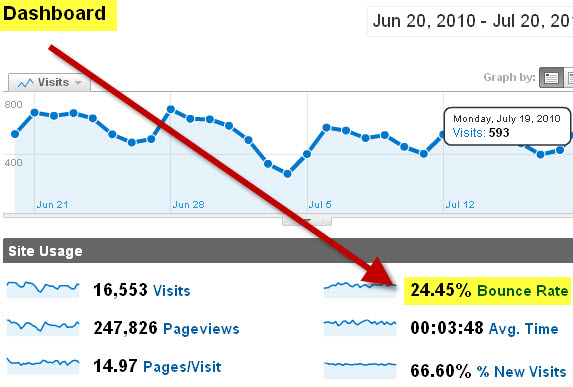
Here are a few other ways deep linking to internal content helps your rankings:
Improves Page Authority: Google likes fresh content, because recent information is more likely to be relevant and useful to users.
Adding fresh content regularly is not the only way to raise your Page Authority. Linking to your older content gives those pages more power and tells Google they’re still relevant.
Your homepage naturally may have a higher PA but you need to work towards improving the authority of internal pages.
Cyrus Shepard explained, in a Moz post, that Google gives fresh content a score based on the date that it was published.
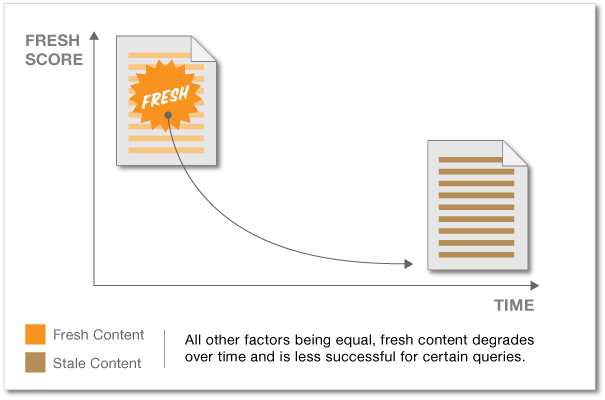
This freshness score can decay over time and it’s also responsible for increasing or decreasing the search ranking of that page. While freshness isn’t important for every page, it still matters!
Makes your internal pages indexable. Consistently linking to internal pages makes it easier for search engine spiders to quickly find and index them.
When linking to your internal pages from other blogs, avoid over-optimization of your anchor text.
Your anchor text is the actual part of your sentence that has the link in it, like this. Use something simple for your anchor text, like your website name (“Neil Patel”), or add a keyword (“Neil Patel’s content marketing”).
An easy way to link to internal pages is in your latest blog post, like I’m doing right now when I say things like you could double your traffic.
The words “double your traffic” are a good example of anchor text, and I linked over to an older post with more tips on growing your blog which is relevant to my current topic.
Advanced SEO Tip 11. Send Link Juice to Lower-Ranked Pages
If you have a page that’s currently on page two or three of Google search results, you can help move it up to page one by passing on quality link juice to those lower ranked pages.
Link juice (aka link equity) refers to outbound links from high authority sources to your content. Since those links are from high authority websites, that reputation rubs off on your site. Essentially, this gives Google an indication that your content is high quality, too.
Let’s look at it this way: you have two websites that are 100% identical – same design, same content. If every other factor were the same, the site with the most links would rank the highest in search results.

This article about indexing used to be on page two of Google’s results for the search term “index your site”.
Now, it’s the third organic search result on page 1!

Voici comment je l'ai fait.
Step #1: Updated the Post
I added new links, content and recent data to bring the post up to date.
I cover how to update your older content in detail in Section 18!
Step #2: Shared It Across Social Media Again
Since I updated the post, I shared it on all my social networks again. This brought in a lot of new traffic.
Step #3: Linked to It From Newer Posts
Every time it was relevant to a new post I was writing, I included a link to this post. This directed traffic to the older post and resulted in people sharing it and linking to it themselves.
It doesn’t happen overnight, but over the span of a few months, I went from page two to almost the top of page one.
Advanced SEO Tip 12. Link to External Sites with High Domain Authority
It helps pass link juice to your content when you get links from high authority domains. Likewise, it also helps your overall trustworthiness in Google’s eyes when you link to high authority sites.
A good place to look for sites to link to is Alltop.
You’ll see some featured sites on the homepage and recent content published by them.

All six of these options would be good to link to, and get links from.
To find something for your topic, just search for your keyword at the top of the page.

You’ll see related categories to what you typed in. I chose SEO here.
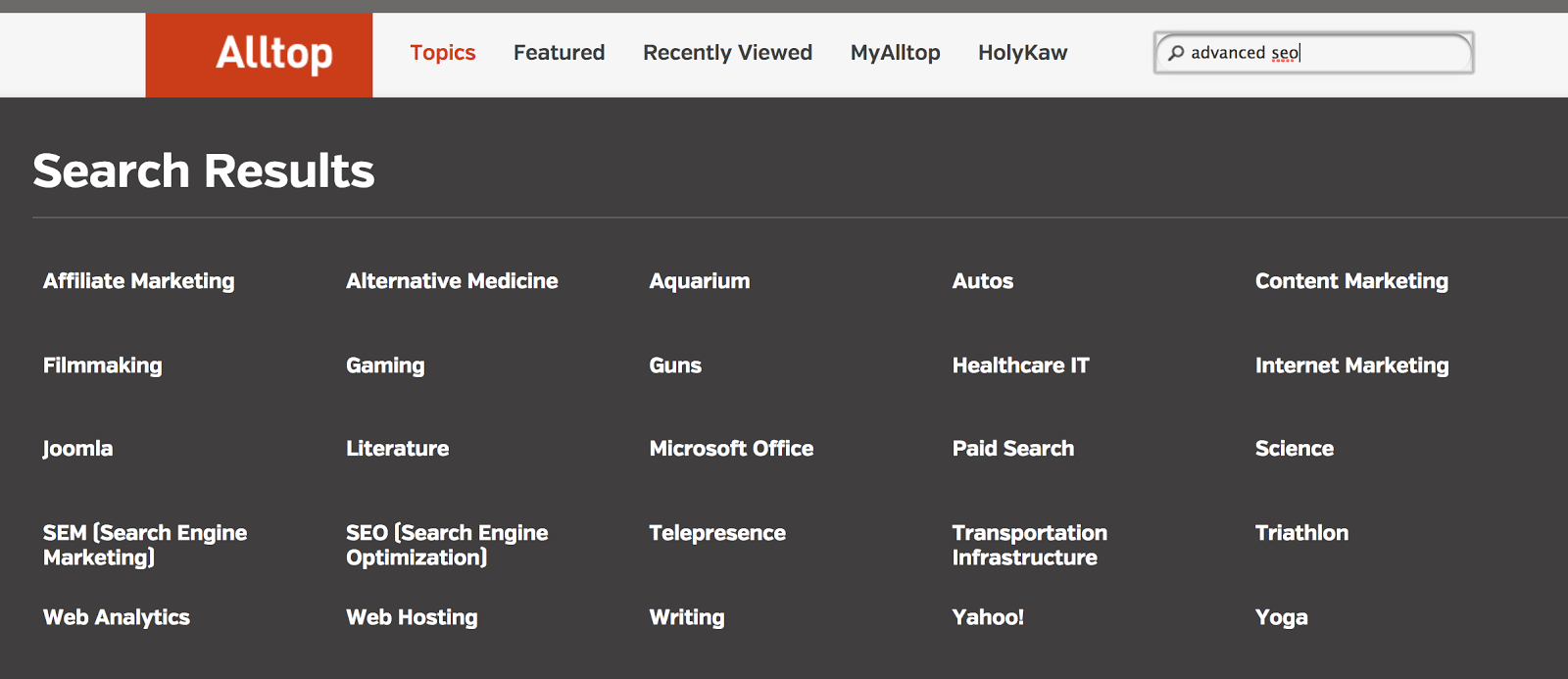
Alltop then shows me the top SEO related content from the following high authority websites:

I could link over to one of them as a data source in my content.
Like if I said that user experience was just as important as on-page SEO for ranking high in search.
Better yet, I could approach these websites and ask them to link back to my content.

They may not link back to you, but a simple email only takes a minute to write. That minute could result in huge traffic gains later on, so it’s worth the time.
Advanced SEO Tip 13. Snag Broken Link Opportunities on Wikipedia to Build Links
This is something a lot of marketers overlook, but it’s very powerful for generating high authority backlinks to your content.
Scan Wikipedia for dead links and claim them as your own!
Didn’t think of that, did you?
There are two types of links you can get from Wikipedia:
- Citation needed: This means someone editing a Wikipedia article mentioned a statistic or fact without linking to a source.
- Dead link: This is a source that was previously linked to but for whatever reason, the website or page does not exist anymore.
If you can write a post about the topic, and be a credible source of information, you can get these valuable links from Wikipedia.
I like to use a tool called WikiGrabber to find these link opportunities. Enter your keyword and click Search.

WikiGrabber then shows me this list of Wikipedia articles that need citations or that have dead links.

You can also use Google to find dead links on Wikipedia. Use the following search term:
site:wikipedia.org “Keyword phrase” “dead link”
For “content marketing”, you get the following results:
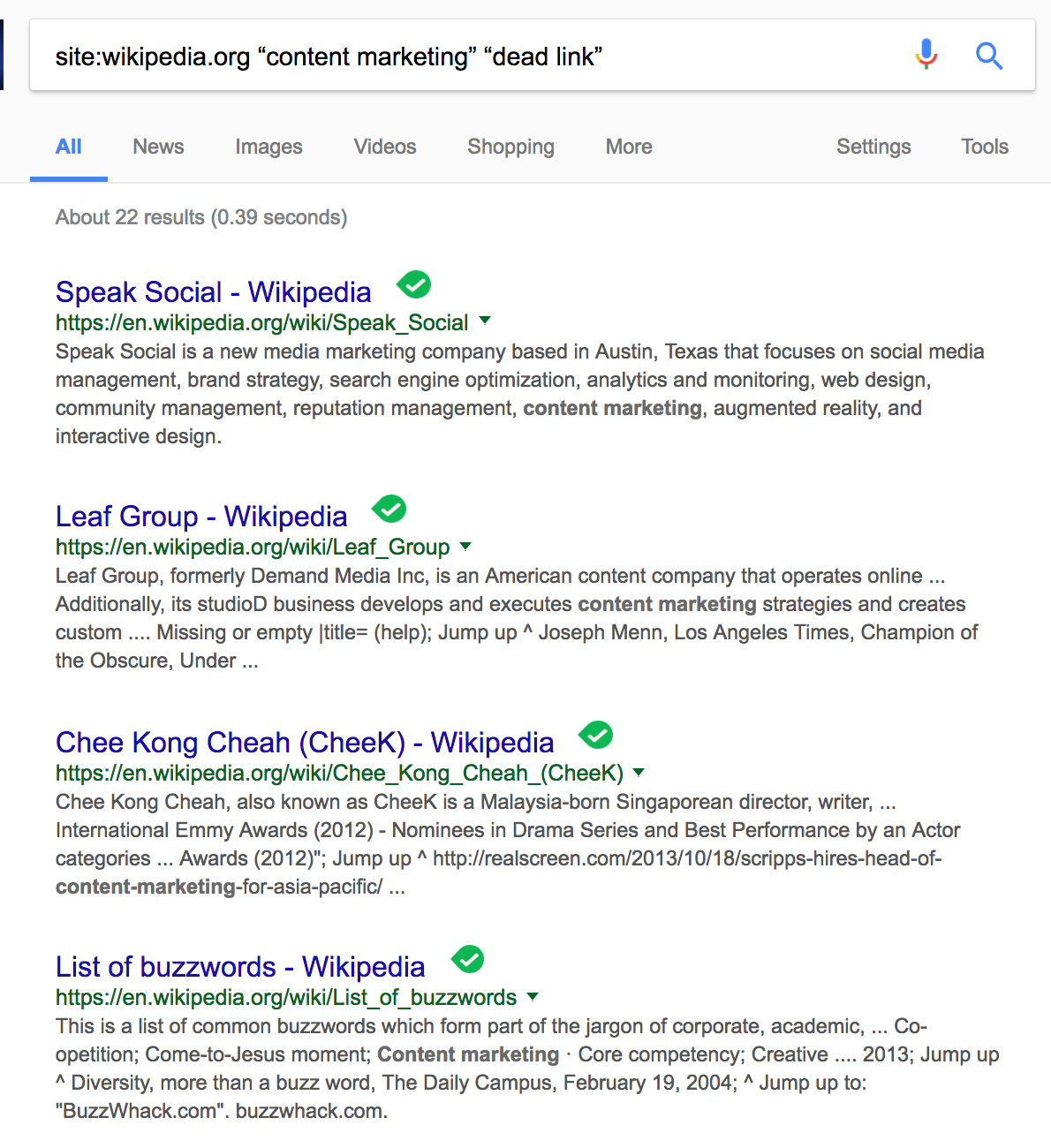
Let’s check out this article on Content Marketing.
Scroll through the article until you see the text (citation needed).

Read over the item that needs a source. If you have content that already backs up this statement, you can move ahead to submitting your link. If not, you will need to write a new post that thoroughly covers the topic and provides verifiable data.
To submit your link, click on the (edit) text beside Digital content marketing.
You’ll get the Wikipedia editor screen. Find the sentence that needed a citation, click at the end of it and click on Cite on the top menu.
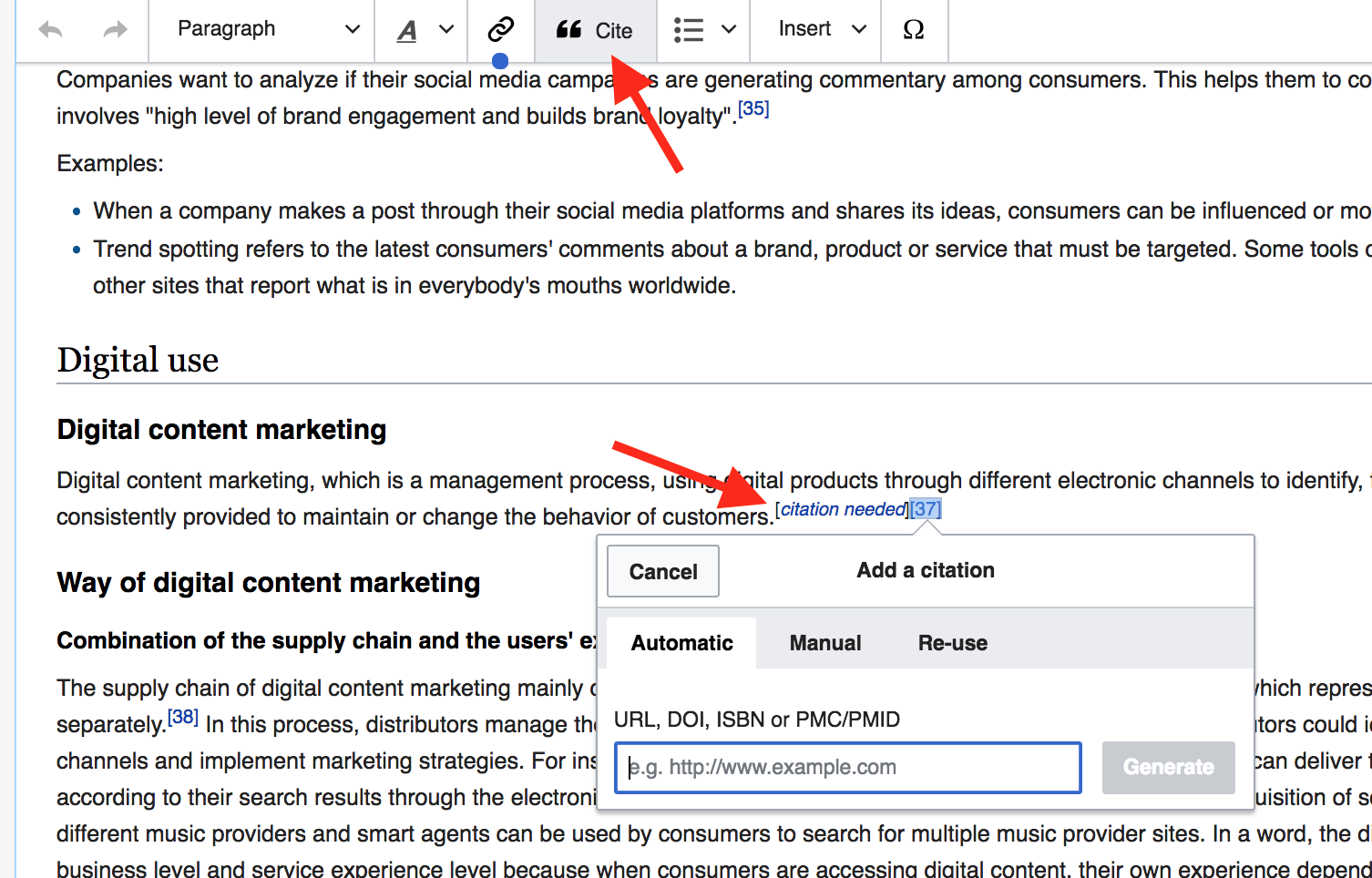
Paste your URL into the box above and click Generate.

You’ll see this screen confirming your citation and marking the date it was added.

To save your changes to the article, click on Save Changes at the top right of your screen.

Your edit will be submitted for moderation. If Wikipedia staff agrees it’s a valid source of data for that point, it will be added to the page and you’ll enjoy increased page authority and traffic from Wikipedia.
Wikipedia links are technically no-follow, which means that they do not pass link juice over to you. However, their domain authority ranking and trust level from Google are very high, so there are still SEO benefits to snagging them!
Advanced SEO Tip 14. Find and Use Competitors’ SEO Keywords
Competitor research is a smart move. Why reinvent the wheel, when all of the hard work of ranking in Google’s top pages has already been done by your competitors?
You can spy on the exact keywords that they’re ranking for and use those same keywords to create better content.
Something as simple as signing up for your competitor’s newsletter can reveal their whole email marketing strategy to you. A little research doesn’t cost anything but your time, and can produce some great new strategies for you to try.
Starbucks made a big splash in China when they studied their competitors’ marketing. Spying helps you improve your own plans to beat the competition based on data, instead of assumptions.
Starbucks’ profit in China has been steadily increasing because they did some simple research.

So how do you find out what keywords your competitors are ranking for right now?
Step #1: Head Over to Ubersuggest
Enter your competitor’s site URL into the search box and press Enter.
Step #2: Click Keyword Ideas in the Left Sidebar
This will give you a list of keywords related to your website.
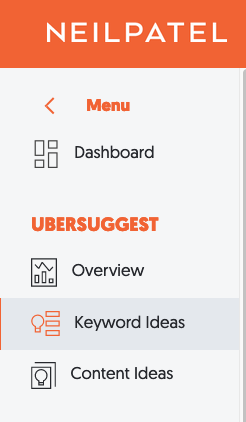
Step #3: Look at SEO Keywords
Scroll down to the last section titled SEO Keywords.
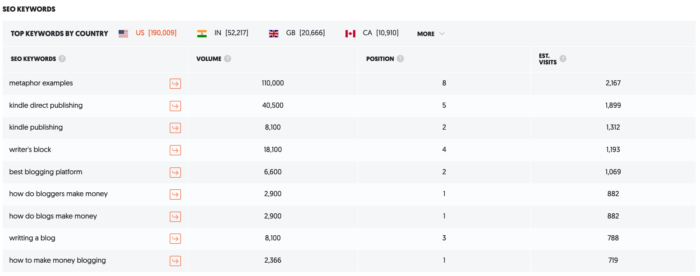
The Position column tells you which Google search result position your site sits in for that keyword. For example, smartblogger.com is in the first organic spot for “how do blogs make money”.
In order to verify whether the keywords are truly ranking at the positions Ubersuggest says, let’s do a quick Google search for “how do blogs make money”.

Definitely the top spot!
Now your job is to create high quality content using those same keywords. Use all the other tools in this list to build trusted links and boost that page’s ranking power.
If you want to get even more ideas for long-tail keywords to rank highly for, head back to the Ubersuggest home page.
- Step #1: Enter Your Head Keyword and Click Search
- Step #2: Click Keyword Ideas in the Left Sidebar
- Step #3: Review the Keyword Ideas
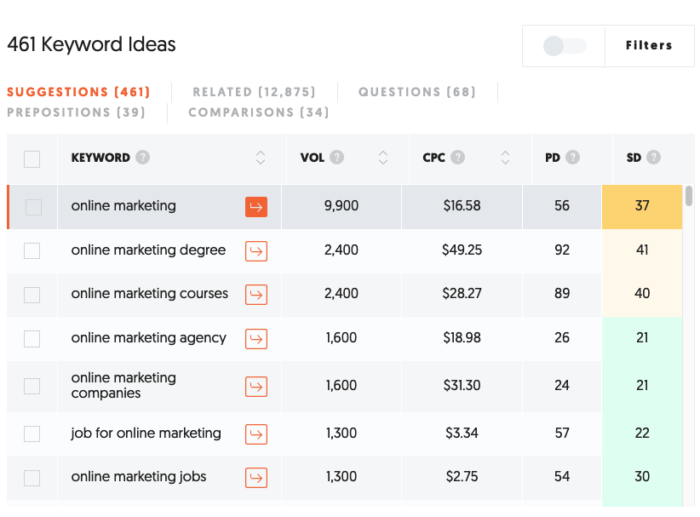
In this example, you’re provided 461 keywords related to “online marketing.” You can now use filters to find long-tail keywords with high volume and a low SEO Difficulty score.
For this search, I set the volume at 800 to 4,000 and the SD at 40 or below.
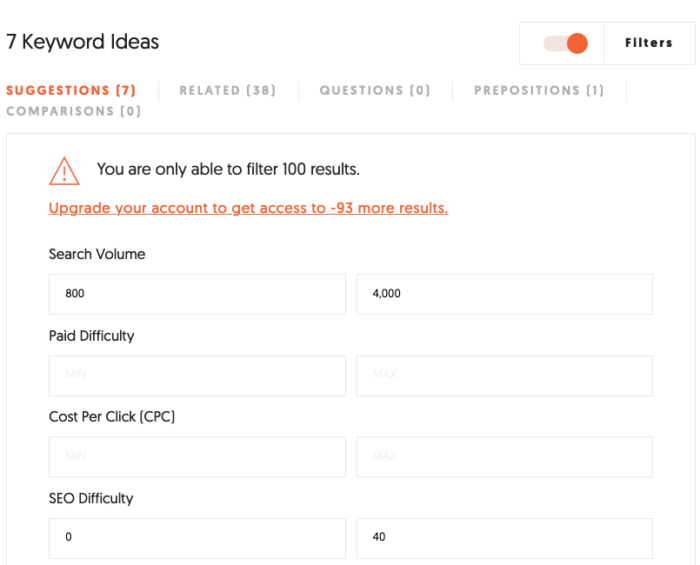
While these search parameters eliminated more than 350 keywords, it also left behind seven ideas to include in future content.
You know the monthly search volume is greater than 800 and the SD is lower than 40. With that, you can confidently optimize for the keyword, knowing that the first page of Google is within reach. When that happens, there’s traffic to be had.
After clicking on a keyword that piques your interest, you’ll see how your competition is doing:

You’re given the following:
- URL for each page in the top 10 of the Google search results
- Estimated number of visits
- Number of backlinks
- Domain score
- Number of social shares
For the keyword “online marketing strategies,” my website is currently in the third position of the Google search results. This is good for roughly 97 visitors per month. However, if I am able to reach the top spot, I’ll pick up another 200+ visitors per month.
The data shows my domain score is in line with the top two search results, but the page doesn’t have nearly as many links or social shares. So, focusing on those two metrics will help me reach the goal of claiming the top search result.
Advanced SEO Tip 15. Use AdWords Copy in Your On-Page SEO
Another great way to steal the spotlight from your competition is to look for keyword ideas in their Google AdWords search ads.
Google AdWords ads are short and already optimized for your competition’s target keywords. If you can produce a quality article that ranks well organically for that same keyword, you can easily establish yourself among your target customers.
With 26 percent of internet users using ad blockers, consumers are warier than ever of paid advertising.
Establishing yourself high in organic search results establishes trust and will display you first to those using ad blockers.
To find some good AdWords keywords to create content around, try searching for keywords you want to rank for:

Analyze the titles and copy used in each of these ads. They should give you at least a few ideas for headlines you can use in new content.
A few from this example could be:
- How to Perform a Free SEO Website Audit
- How to Generate More Calls, Leads and Sales with Local SEO
- Increase Your Website’s Domain Authority in 30 Days
I wrote the first post below for QuickSprout using “How to Perform an SEO Audit”, and included the word free in the title.
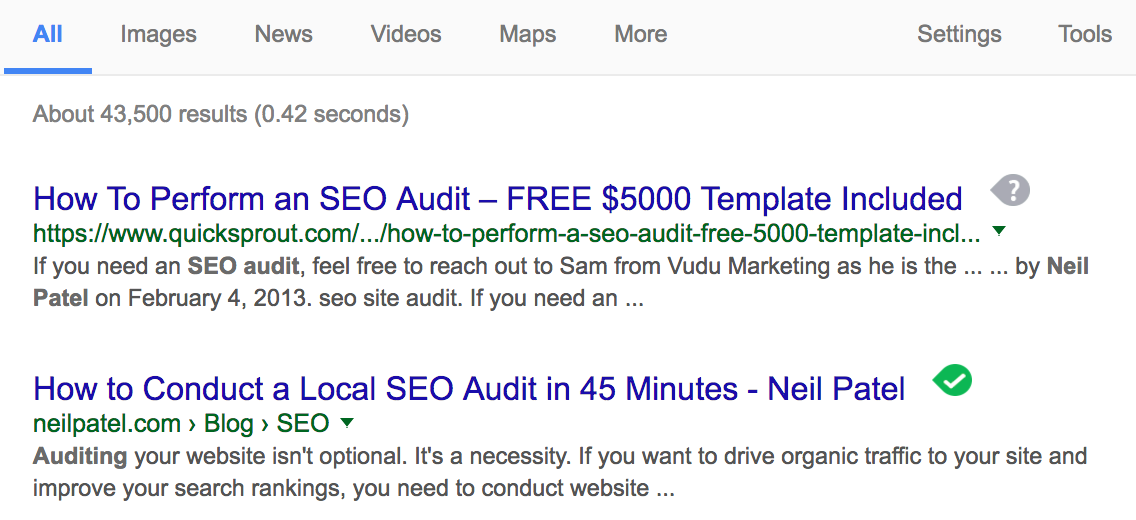
In that post, I broke down all the steps to do a full SEO website audit and included a template for users to download.
It remains a very popular post and still converts at over 50%. All for free, with no paid AdWords ads!
Advanced SEO Tip 16. Use Multiple Keywords in SEO Page Titles
Your SEO page title is the title that is displayed in Google search results. Here’s an example.
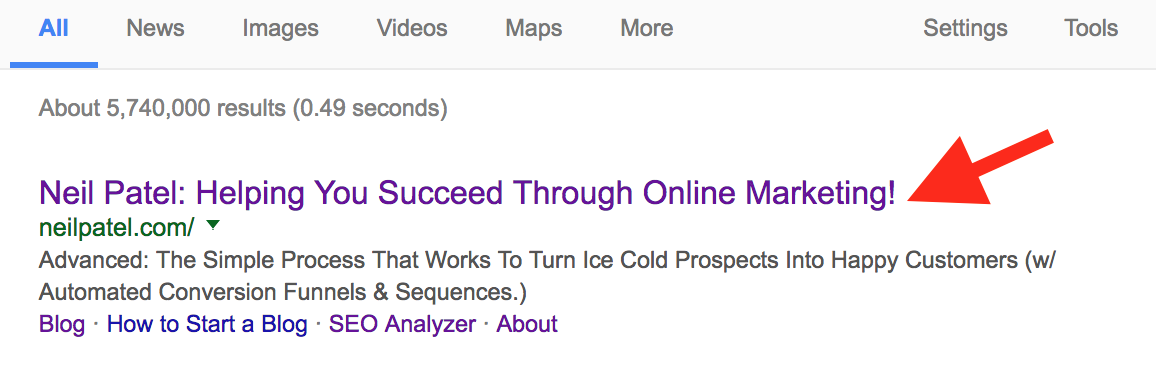
You want to ensure that each page title for each page and post on your website contains a keyword.
A strategy I have found particularly effective is to include multiple keywords within each page title. Make sure not to be spammy with this or it could end up hurting you.
By spammy, I mean just cramming keywords in there for the sake of it, even if they sound a little off. Or, by using spam trigger words that instantly make Google think your content is less than legit.
Let’s say your post is about hair colors for fall and you want to rank for the following keywords:
- Hair colour
- Autumn hair
- Autumn hair trends
Here are a few examples of a page title that combines those in a natural-sounding way:
- Autumn Hair Trends: The Best Hair Colors of the Season
- 5 Hot Hair Colours Right Now: Autumn Hair Trends
- And here’s an example of a keyword-stuffed, not good page title:
- Autumn Hair Colour Trends – Hair Colour for Autumn
See the difference? The first two sound natural and like you could picture seeing them online. The last one just seems spammy and like it’s trying too hard.
If your page titles sound like you’re trying too hard, you probably are.
Advanced SEO Tip 17. Monitor Google Search Console Stats
Google Search Console is a powerful tool to help you track potential issues with your site that affect your rankings.
If you haven’t already signed up for it, you can see how to do that step by step right here.
There are three main things you want to check regularly in Search Console:
- Watching for crawl errors, like 404 pages
- Submitting new sitemaps
- See which keywords people are using to find you
When you first sign in to Search Console, you’ll see your Dashboard page.
Under “Coverage,” you’ll see any URL erros.
As you can see, I have seven recent URL errors for my blog.

I had corrected a lot of 404 page errors in previous months that were caused by a switch to a new webhost, as you can tell by the red line. It’s important to keep monitoring these reports often as new errors can pop up anytime, like these seven have!
If you click on one of the URLs in the list, you’ll see this message.

404 errors don’t have a direct impact your search result rankings, but they don’t make for a great user experience which can impact SEO.
You don’t want to show up high in search, get someone excited to visit your site, then disappoint them with a 404 page when they get there, right?
Fortunately, they’re very easy to correct in Search Console. For each 404 error, click on Fetch as Google in the screenshot above.
Search Console will tell you the result of what Google’s indexing spider sees.

In this case, my 404 page was showing up that way because it’s being redirected to a new page. This can be easily solved by getting my site re-indexed. Click on Request Indexing button, and you’re done.
There’s also an easier way: you can submit a new sitemap for your full site.
Click on Sitemaps on the left-side menu.

Enter in the URL to your sitemap. For most people, this is just “sitemap.xml” after your domain name, like neilpatel.com/sitemap.xml.
If you need help creating a sitemap, use this guide on How to Create an SEO-Boosting XML Sitemap in 20 Minutes (or Less.)
When you submit a new sitemap, the status changes to Pending.

Getting Google to re-index your site will ensure any 404 errors that you know don’t exist are marked as fixed.
Another great use of Search Console is to find out the keywords people are using to find you.
Click on Performance in the left-side menu.
You’ll see a list of keywords that people typed into Google that displayed your website, whether they clicked on your page or not.
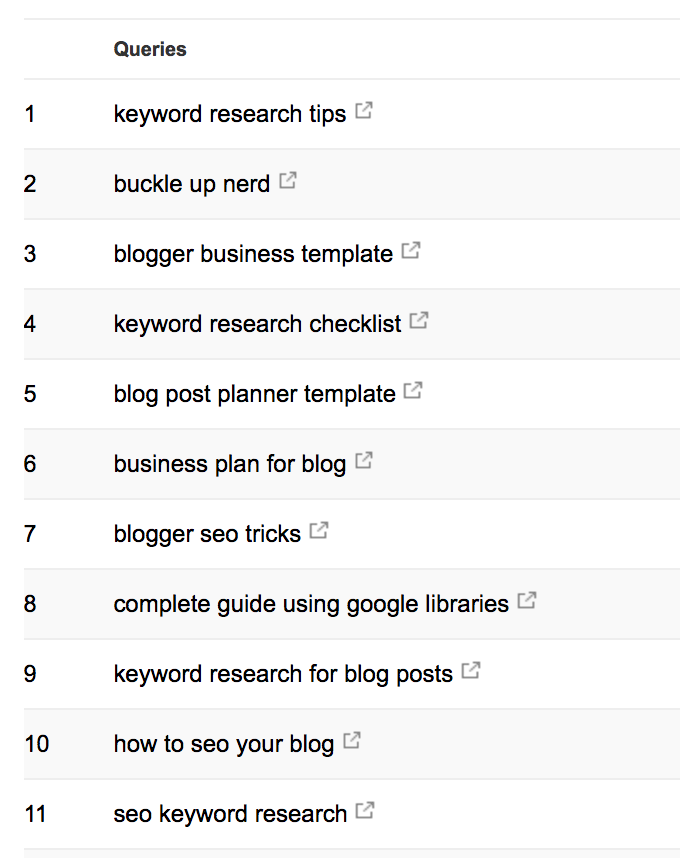
Looking at how people found you can tell you a lot about what you’re ranking well for. If the keywords in your list aren’t the ones you want to rank for, it’s time to optimize more of your content!
Advanced SEO Tip 18. Update Old Content
If you’ve been blogging for more than three months, you’ve got a goldmine of content in your archives to repurpose.
You’ve undoubtedly written some posts that are still generating organic traffic. You can improve those posts and leverage their authority for higher search rankings.

Start by making a list of your top performing content.
Step #1: Find Posts That Need Some Love
Log into Google Analytics. Click the “Behavior” tab on the left side.

Step #2: Click Site Content -> All Pages
Look for the best performing posts from three to six months ago. These posts are doing well, but a refresh could drive even more traffic.
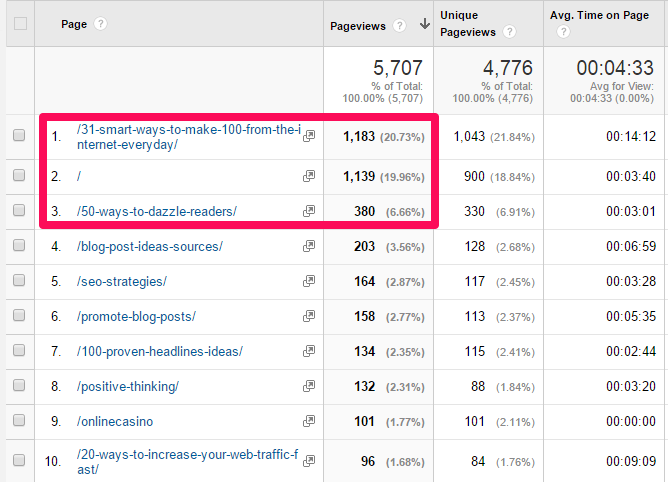
Step 4: Update Old Posts
Here’s what I do to update my best performing posts to keep them fresh and popular:
Write a Sharable Headline
The most critical step of all is to write a headline that will inspire people to share your post, and that contains your SEO keyword.
So, if your old post was titled “How to Make $10,000 From Your Blog,” you could make it more sharable by adding a bit of personal flair. The headline should evoke curiosity, but still maintain its clarity.
Something like this: How I Make $10,000 a Month From My Blog While Traveling the World
That’s a bit more fun, huh?
You could even add a number to the headline, as people more frequently share headlines that contain a number. Headlines like, “7 Reasons Why Blogging Can Be a Career”, etc.

Par exemple:
- How I Make $10,000 Blogging Part Time (and 3-Step Plan You Can Follow)
- How I Made My First $10,000 Blogging From Home in 30 Days
Take a look at this Copy Hackers headline. It’s thought-provoking, keyword-rich, clickable and clear:

Add Customer Testimonials or Notable Mentions
Now that you have some experience, let it show in your content.
Customer testimonials are huge for marketing. When it comes to including a testimonial within a piece of content, that content has an 89% success rate.
Your reader may not jump on board if you’re the only one saying how awesome you are. But if someone else backs it up, your authority and influence will increase.
When you get a testimonial, find a piece of content that fits it and include that testimonial.
Update Old Data and Images
If your post was originally from 2014, you clearly need to update your data sources.
If your website has gone through a redesign during that time, you’ll likely need to update images in the post to be in line with your current branding.
I do this regularly with my best performing content. For example, this guide on getting your website indexed is one of my most popular posts.
Whenever something changes with Google’s algorithm or indexing rules, I update that post so it’s always up to date. I don’t want new users coming to my site and finding outdated info, so it’s important that my top content is accurate.
Another word for content like this is your ‘cornerstone content’.
Cornerstone content is basically the foundation of your blog. They are the articles you are most proud of and the ones that are the most unique, in-depth and informative.
Brian Clark describes it as, “It’s what people need to know to make use of your website and do business with you.”
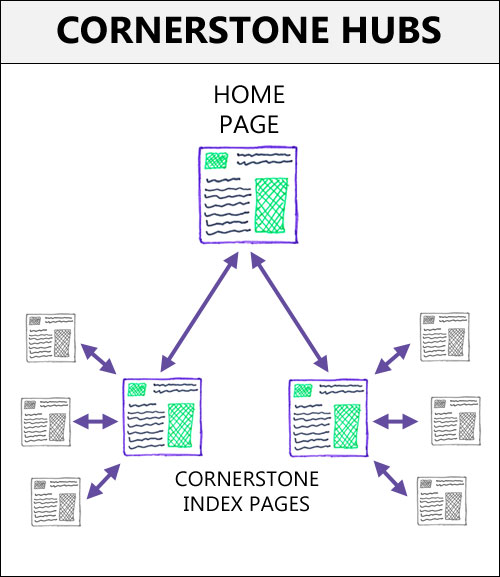
An easy way to keep track of your cornerstone content is to create a spreadsheet. Add the following columns:
- Post title
- Post URL
- Topic
- Main keywords
- Last Updated
Scan through your list every few months and ensure that none of these posts go too long without being updated. Don’t go more than six months without updating one of your cornerstone pieces.
Advanced SEO Tip 19. BONUS – Revamp Old Articles With More Organic Traffic Potential
In the previous section, we covered how you can keep your best performing articles fresh and optimized. But what about the articles that didn’t go over so well?
You should also be updating your lowest performing content to improve it.
You know it’s a good topic and that people want to know about it, otherwise you wouldn’t have written about it in the first place. Revamping an old underperforming article is a sure way to get more organic search traffic.
What’s the alternative? Writing a new post from scratch. It may do well, or it could flop too. It’s worth the effort to revamp an old post!
Here’s how to turn your previous content failures into organic search stars:
Make a List of Underperforming Content
Open up Google Analytics and click on Behavior > Site Content > All Pages.
Look at page views, average time on page, and bounce rate.

If you click on the arrow next to Pageviews, you can see the pages with the least amount of traffic. These are pages that need some thelp!
Analyze Keywords
For each of your lowest performing posts that you want to update, run them through whatsmyserp.
Enter the keyword you want to check the ranking of and your post’s URL, and click Go.
You can enter in multiple searches one at a time and see all your results at the bottom of the page.

This post ranked 14 for sales funnel — which might isn’t even on the first page.
If my goal were to rank higher for ‘sales funnel’, I now have some data to start with. There are over 200 factors that go into search engine rankings, but updating this old post with better optimization for that keyword will help boost its position.
The top four organic search results get 69.6% of all traffic.
The higher you can get underperforming content to rank in search results, the more eyeballs will be on it, and the more clicks you’ll get.
Update the Post
Similar to the section above, you’ll want to update:
- Old data or citations
- Images or broken links
- Optimize for keywords you want to rank higher for
- Add new insights from your experience, or recent news that’s relevant
- Add a testimonial or case study
I recently went through this process with this post about starting a blog.
Before I updated it, it was ranking on page three. After expanding the post to over 3,000 words, updating all the images and screenshots, adding new information and resharing it to my network, the post is now on page one for “how to start a blog”.

The post has received a 167% jump in traffic since I revamped it and it’s now my second most shared post ever!
Relaunch the Post
You can’t just press update and expect the world to know you just added a ton more value to your old post. You need to tell people.
It’s important to edit the publish date of the post to today’s date. You don’t want it to get buried in your archives, or for Google to think it’s old news.
When you’re ready to relaunch the post, change the publish date. In WordPress, there’s an edit link next to the date you can click.

Just change that to the current date.

This makes your revamped post show at the top of your blog feed so it looks brand new and more people see it.
There are a few more things you’ll want to do right away:
- Share it on social media
- Contact anyone mentioned in the revamped content and ask them to share it out too (this is very effective!)
- Send it out to your email list
Revamping old content has been really successful for me.
It would have taken me 10x as long to come up with all new post ideas and write them instead of editing the ones I already had. Making use of existing content is always more efficient than starting from scratch and the traffic results prove it.
Conclusión
A blog is a powerful brand marketing tool.
Maybe that’s because, by their very nature, blogs provide a personal touch that’s not found elsewhere.
In order to maximize your blog’s potential, you have to make sure it gets found in search results.
These advanced SEO techniques may not be the easiest to implement – they certainly require more effort than basic keyword research and link building – but they are incredibly effective. Using these strategies can double your search traffic.
Remember the human beings on the other side of the screen and write for what they want to read. Focusing on user intent and trying out these 19 advanced SEO tips is a recipe for traffic success.
Have you tried any of these advanced SEO techniques before? What results did you get and how long did it take to see them?